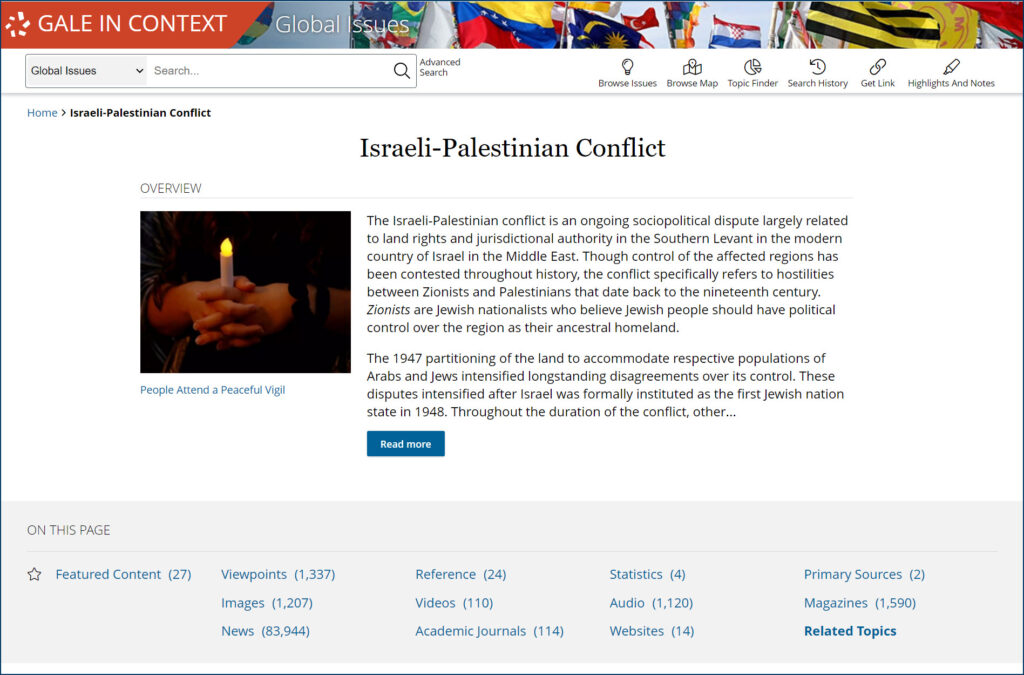| By Gale Staff |
For those developing and revising their curricular goals for the year, it’s important to integrate a variety of perspectives for any given topic. There’s no one-size-fits-all narrative for the often complicated subjects your students explore. Studying the nuances and different sides of modern-day global affairs helps K-12 learners develop critical-thinking skills. Plus, they’ll better understand how international conflicts aren’t often straightforward, and their solutions demand a patient, open-minded approach.
As a Gale subscriber, one of your district’s strongest assets is its access to vetted and varied content. Specifically, Gale In Context: Global Issues houses materials related to government, science, health, and culture—and it represents voices from around the world. No matter what subject you teach, this resource lends itself to a range of academic topics.
Alongside the sheer size of the collections, your students can take advantage of Gale’s user-friendly organizational and navigation features. While at first similar to a traditional search engine, students will soon discover that Gale’s functionality goes well beyond a conventional internet query. With Gale In Context: Global Issues, students can filter results by a publication’s nationality and, therefore, obtain first-hand news from within a country’s borders. This exercise guides users toward multiple perspectives rather than limiting them to the viewpoints of prominent Western media.
Explaining the Israeli-Palestinian Conflict
Gale In Context: Global Issues allows educators to support various perspectives via our collection of international publications. Few global disputes are as complicated and longstanding as the Israeli-Palestinian Conflict, but Gale provides a portal to start the conversation. Begin with Gale’s comprehensive summary, featuring essential background, targeted critical-thinking questions, and a synopsis of recent developments. From there, students can browse related featured content, biographical entries, statistics, primary sources, images, videos, audio files, academic journals, and more.

After developing a general sense of the conflict’s foundations, it’s time to leverage Gale’s extensive navigation features and find resources outside the United States that offer a balanced perspective. Using the publication search option will help you narrow your search to just those publications from Israel, for example. You can even search for specific topics with each resource. Find scholarly journal articles on the peace process from Ariel University, one of Israel’s leading research institutes. Or, learn how humanitarian aid is disbursed by the United Nations Relief and Work Agency (UNRWA) to Palestinian refugees and what challenges the UNRWA are facing by reading the latest news from Palestine News Agency (WAFA). As you develop your curriculum, use these international resources to spark classroom discussions on inequality, religious strife, propaganda, and power.
Learning How Climate Change is Viewed Globally
Across the globe, our youngest generation is particularly invested in preventing climate change. Many see an investment in climate change as an investment in their own futures and well-being. However, perspectives vary from unified supporters to climate change deniers. For example, the United States left the Paris Agreement in 2020, only to rejoin those efforts when President Biden took office. But what about other nations? After all, climate change is a global issue that affects everyone. To answer this question, begin with Gale’s climate change portal. Then, filter the news results to international publications; there are dozens of options to choose from.

One of the greatest benefits of using Gale In Context: Global Issues is that educators and learners are able to evaluate any topic from multiple perspectives. Readers can look at any topic with a global lens, allowing them to form their own opinions based on facts and firsthand accounts.
You can explore commentaries from Canada’s Toronto Star. Consider climate change investment concerns from Ireland’s breakingNEWS.ie. Read editorials from the Philippines’ Mindanao Times. You can even find stories that question and criticize the U.S. deniers. Push your students to consider why a scientific phenomenon like climate change inspires such varied perspectives worldwide. Discuss why some in power might benefit from spreading false information and why reviewing a variety of sources from throughout the world is good practice.
Comparing Perspectives on Vaccines
Now that schools are somewhat back to normal and the pandemic has ebbed, the media coverage and debate around vaccines have also abated. However, addressing the science behind vaccines and debunking false information about them is still an essential conversation for your young learners. Schools play a vital role in educating the next generation about how vaccines and viruses work.
Of course, COVID-19 and other viral diseases affect nations beyond U.S. borders, and vaccines are critical for global public health. What’s more, Americans aren’t the only ones touched by mistruths and false science. Read an article from the Philippines’ Manila Bulletin that discusses the efficacy of modern medicine and the risk that misinformation poses to others. Similar doubts and vaccine resistance plague the citizens of Sri Lanka, claims an editorial from the Sri Lanka Daily Mirror. Your students can easily draw parallels between different countries’ coverage of vaccinations and the harms of misinformation.
Discussing Global Gender Disparities
Encourage your students to research how different countries view gender equality and how women in the United States may or may not share similar experiences. For example, westernized nations like Canada and Australia discuss gender issues such as the wage gap and paid maternity leave. While important topics, especially regarding equal rights and healthcare, women in these countries are nonetheless relatively advanced regarding their roles in society. They can vote, attend college, and work in whatever professions they like.
With Gale In Context: Global Issues, your research is not limited to Western perspectives. Consider how women are advancing their cause in countries like Pakistan or Ghana. What are the issues with which these women are concerned? In India, women face outdated work restrictions and, especially in rural areas, struggle to access basic education. In Kenya, women worry about job security should they get pregnant. In Iran, women protested for the basic right to wear clothing of their own choosing, even under threat of violence. By diving into gender rights and different perspectives worldwide, students can learn to appreciate their freedoms and help stand up for basic human rights.
Expanding Research Opportunities and Inspiring Global Citizens
With a simple search in Gale In Context: Global Issues, you’ll find thousands of resources, including news pieces and magazine articles from dozens of international publications. In our increasingly interconnected world, it’s vital that your students develop a curiosity for and appreciation of diverse, global perspectives. Identifying similarities, despite international borders and cultural barriers, helps inspire compassion and understanding for others around the world. Expanded knowledge gives students the power to find solutions through global perspectives and opens their minds to challenges and opportunities outside of their immediate world.
If your school district is not a current Gale subscriber, speak to your local education consultant today.

